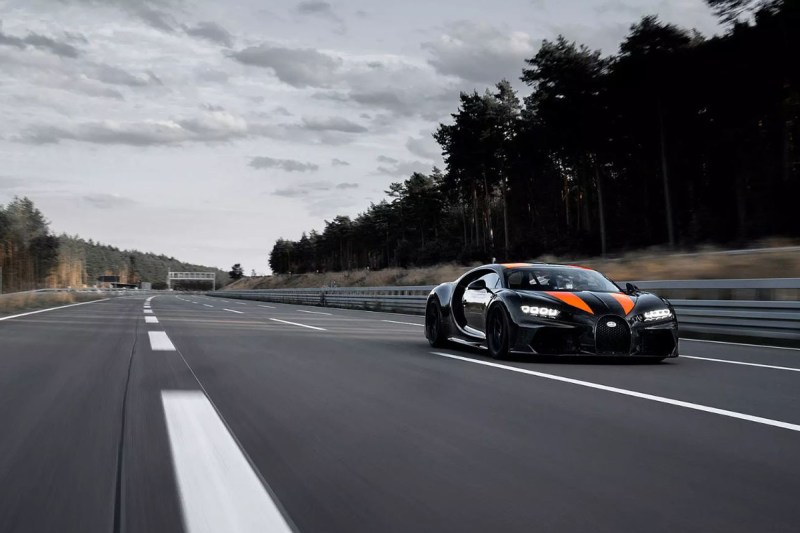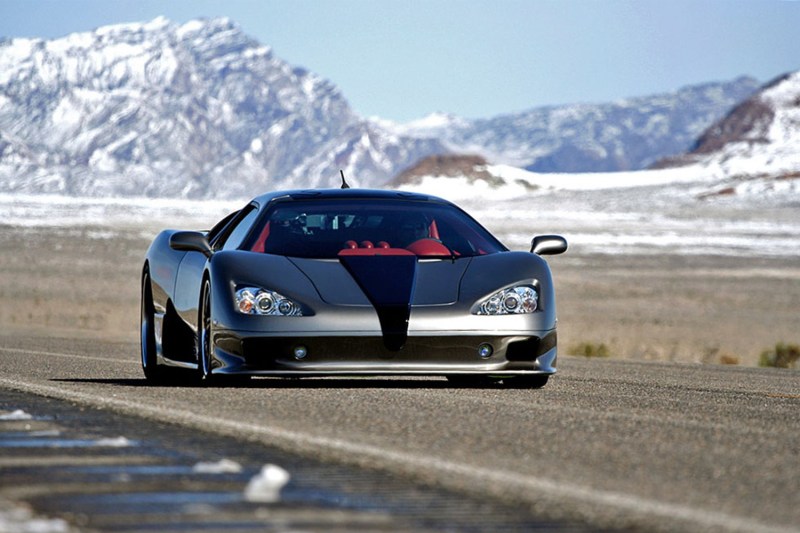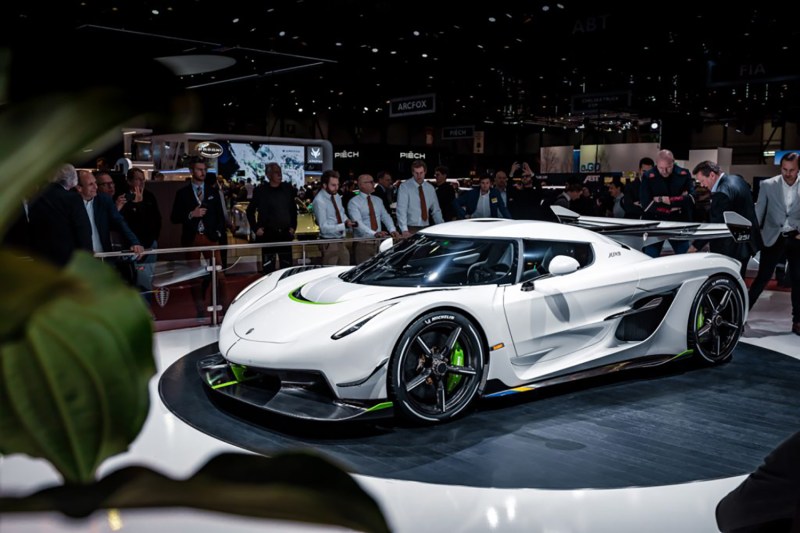
Despite the push to make more fuel-efficient vehicles with smaller engines, automakers are using high-powered supercars to attempt to set new top-speed records. Automakers have made large strides in aerodynamics and have found a way around emissions by keeping production of record-setting vehicles incredibly limited. Like lap records, top-speed runs are purely for bragging rights. There’s no incentive to have one of the fastest cars in the world beyond giving automakers the ability to say that they have one of the fastest
Unlike other figures that are used to differentiate vehicles from one another, like zero-to-60 mph times, cornering G-force, or quarter-mile times, setting a new top speed record is insanely difficult. Beyond ensuring that a car has the right amount of power and efficiently flows through the air, finding a long enough stretch of road to get a car up to 300 mph is nearly impossible. That’s why top speed records rarely get broken.
Horsepower still reigns supreme as the primary metric to compare
These vehicles are the fastest
Bugatti Chiron Super Sport 300+: 304 mph
In August 2019, Bugatti topped the formerly reigning Hennessey Venom F5. Not only that, but the Chiron Super Sport 300+ also became the first car to break 300 miles per hour on the track. The final record was 304.773 mph with racing driver Andy Wallace at the wheel on Volkswagen’s Ehra-Lessien test track in Germany. If 300+ mph seems hard to comprehend, you don’t lack imagination. Covering 450 feet in a single second is mind-bending stuff.
Bugatti holds the crown for now, but the manufacturer may bow out of the race. “We have shown several times that we build the fastest
Hennessey Venom F5: 301 mph (claimed)
Hennessey Performance Engineering previously owned the top spot of this list with its Venom F5. The successor to the record-setting Venom GT, the F5 has a theoretical and claimed top speed of 301 mph, besting the next fastest car by a solid margin. Too bad Bugatti had to meddle in the top-speed wars again.
The Venom F5 uses a carbon fiber chassis and is powered by a 7.4-liter twin-turbocharged V8 good for 1,600 horsepower. While Hennessey has yet to legitimize its claims, the F5 will reportedly dash from 0 to 249 mph and back to 0 in less than 30 seconds. That’s about how long it takes a mild sports car just to get from 0 to 100 mph.
SSC Tuatara: 295 mph
On October 10, 2020, SSC claimed that its monstrous Tuatara averaged a top speed of 316.11 mph on its way to set a new record for the fastest production car in the world. Things went downhill for SSC after the run. The speed record came under scrutiny because people spotted inaccuracies with SSC’s videos. It wasn’t until July 2021 that SSC officially stated that the Tuatara hadn’t hit 316 mph.
Because of all of the hoopla, SSC headed to Johnny Bohmer Proving Ground in Florida to attempt another run on May 14, 2022. There, the Tuatara hit a top speed of 205 mph. That’s nowhere near the 316 mph SSC promised, but it is an actual run without any funny business.
SSC isn’t done chasing the speed record with the Tuatara, so we could see the
Koenigsegg Agera RS: 278 mph
If you’re only interested in proven claims, then the world’s fastest
On November 4, 2017, the Nevada Department of Transportation closed an 11-mile stretch of road just outside Las Vegas. Koenigsegg turned up with a customer-owned Agera RS and Koenigsegg factory driver Niklas Lilja put down two high-speed runs (in opposing directions). The average pace (including one run at 285 mph) was recorded by the Guinness Book of World Records.
Hennessey Venom GT: 270 mph
When Koenigsegg set a new official top-speed record, Hennessey forfeited the title. The Hennessey Venom GT came out of nowhere to topple the mighty Bugatti Veyron. In 2014, Hennessey revealed a Lotus-based Frankenstein
With approval from the Kennedy Space Center, Hennessey recorded a top speed of 270.4 mph. Though the Guinness Book of World Records approved the run, it has received a fair bit of criticism. For one, most top-speed records are taken from an average of two runs in opposite directions (like Koenigsegg did with the Agera RS). Also, the Venom GT is a hand-built, low-production vehicle. Some have questioned whether it deserves to be counted among series production
Bugatti Veyron Super Sport: 268 mph
Before Hennessey and Koenigsegg jumped into the top-speed fray, Bugatti dominated the world’s fastest category. Unlike its upstart rivals, Bugatti benefitted from the massive cash reserves of its parent company, Volkswagen. A tremendous investment of time and resources yielded the Bugatti Veyron in 2005. The $1.7-million Veyron used a quad-turbocharged, W16 engine to deliver 1,001 horsepower to all four wheels.
Impressive as it was, the 250-mph Veyron was soon trumped by the 256-mph SSC Ultimate Aero. Bugatti went back to the drawing board and returned with the Veyron Super Sport. An impressive 1,200 horsepower and a slew of aerodynamic improvements helped the Super Sport to a top speed of 268 mph, clocked at Volkswagen’s Ehra-Lessein test track. Bugatti also developed a convertible version, dubbed the Grand Sport Vitesse, which still holds the record for the fastest open-top production car at 254 mph.

SSC Ultimate Aero TT: 265 mph
For the seventh fastest car in the world, we have to travel back a few years to 2007. On September 24, 2007, Shelby
The wedge-shaped

Bugatti Chiron: 261 mph
Introduced in 2017 as a replacement to the Veyron — the once record holder of the top speed record — the standard Chiron. Even the upgraded version of the Veyron, the Super Sport, topping out at 257.87 mph, was beaten by this powerhouse of a machine. Bringing to bear 1,479 horsepower and a 0-60 time of 2.6 seconds, the Chiron, while not matching the speeds of its Super Sport variant, comes in at a remarkable 261 mph.
It is also important to note, for any prospective buyers looking to enter the field of high-speed car ownership, that the Chiron production run contained 500 examples of the vehicle. This means that the Chiron is, relative to the other
McLaren Speedtail: 250 mph
The McLaren Speedtail has an asterisk next its top-speed run, because it never actually made a top-speed run in the same way as the other
Unlike most of the

Bonus: Concept or near-production cars
Koenigsegg Jesko: 300+ (claimed)
Though the Koenigsegg Agera RS takes the top spot in terms of the fastest car on Earth, the carmaker isn’t resting on its laurels. Teased well ahead of its 2019 Geneva Motor Show debut, Koenigsegg finally let slip what it has been working on: The Koenigsegg Jesko, the Agera RS replacement. The V8 engine and 9-speed transmission (dubbed the Koenigsegg Light Speed Transmission) promise up to 1,600 horsepower (with biofuel — otherwise we’re looking at 1,280 horsepower).
Koenigsegg makes bold claims as to its projected top speeds. At a minimum, it’s expected to top out at a marvelous 330 mph, while the manufacturer claims that it could very likely hit up to 350. While there are not yet any official record-setting sources backing up these claims, this is certainly a car to watch.
Dagger GT: 315 mph (claimed)
Back in 2012, American automotive startup TranStar Racing released plans for a production
Devel Sixteen: 320 mph (claimed)
Of all the ridiculous
Rimac C_Two: 256 mph (claimed)
The Rimac C_Two is unlike any other vehicle on this list because it’s all-electric. While automakers like Tesla and General Motors are worrying about range, Rimac is focusing on all-out performance. That explains why the C_Two has some of the most insane figures of any car on the market.
Each wheel gets its own individual electric motor for a combined total of 1,914 horsepower and 1,696 pound-feet of torque. No, those aren’t typos; it’s one of the advantages of electric powertrains. Thanks to loads of carbon fiber, active aerodynamics, and an impressively low drag coefficient of 0.28, the electric hypercar has a claimed top speed of 258 mph. Additionally, the C_Two will be able to get from zero to 62 mph in just 1.9 seconds. Not too bad for an electric car.



